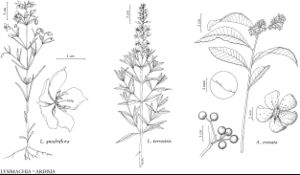Ardisia crenata
Bot. Mag. 45: plate 1950. 1817 ,.
Shrubs, not stoloniferous, 1–1.5 (–3) m; branchlets minutely reddish glandular-papillate. Leaves: petiole 6–10 mm, glabrous; blade elliptic, narrowly lanceolate, or oblanceolate, 7–15 × 2–4 cm, margins crenulate or undulate, subrevolute, (bearing large vascularized nodules), apex acute or acuminate, surfaces minutely reddish glandular-papillate. Inflorescences terminal, on specialized, 2-leaved or 3-leaved lateral branches, umbels or cymes, 5–18+-flowered. Pedicels sometimes erect, 7–10 cm, minutely reddish glandular-papillate. Flowers: sepals (4–) 5 (–6), oblong-ovate, 1–1.5 (–2.5) mm, margins entire, apex rounded or obtuse, glabrous; petals (4–) 5 (–6), white or rarely pinkish, ovate, 4–6 mm, margins entire, apex acute, punctate, glandular-papillose adaxially near base; stamens shorter than petals; anthers triangular-lanceolate, apex acute, punctate abaxially; ovary glabrous; ovules ca. 5, uniseriate. Drupes red, 6–8 mm diam., punctate.
Phenology: Flowering May–Jun; fruiting Jul–Dec.
Habitat: Acidic soil of suburban and urban woodlands and hardwood hammocks
Elevation: 0-200 m
Distribution

Introduced; Fla., Ga., La., Tex., Asia (China), Asia (sw India), Asia (Japan), Asia (Malaysia), Asia (Taiwan), Asia (Vietnam), Pacific Islands (Philippines)
Discussion
Ardisia crenata has naturalized from cultivation and does not appear invasive; it is included in some Florida invasive plant lists. It has often been misidentified as A. crispa (Thunberg) A. de Candolle in the horticulture trade. Ardisia crispa, while also belonging to subg. Crispardisia, may be easily recognized by the bacterial leaf nodules in the crenations of the leaf margins. It is often used in living potted flower arrangements; it needs little attention if planted in acidic soil. Its bacterial leaf nodule symbiosis with Phyllobacterium myrsinacearum has been well documented (B. Lambert et al. 1990); the significance of this symbiosis remains controversial (N. R. Lersten and H. T. Horner 1976; C. D. Nakahasi et al. 2005). Ardisia crenata may be easily distinguished from A. crispa by its taller habit, 1–3 (versus shorter than 1) m tall, lack of creeping rhizomes (versus rhizomes present), adaxially canaliculated (versus flat) petioles (6–)8–10 (versus 5–8) mm long, its leaf margin nodules ellipsoid (versus rounded), and obviously vascularized (versus obscurely so). We have seen A. crispa in greenhouses and in horticultural catalogs; we have not seen it cultivated in gardens or escaped from cultivation.
Selected References
None.
